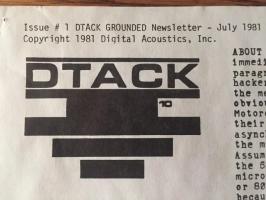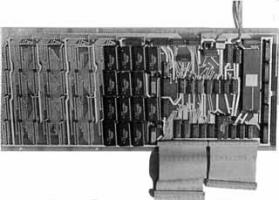Copy Link
Add to Bookmark
Report
HOMEBREW Digest #1981

This file received at Hops.Stanford.EDU 1996/03/11 PST
HOMEBREW Digest #1981 Mon 11 March 1996
FORUM ON BEER, HOMEBREWING, AND RELATED ISSUES
Rob Gardner, Digest Janitor
Contents:
Re: Channeling (Algis R Korzonas)
re:repitching trub (Shawn Bleet)
Help! Is My Beer Infected? ("Wayne A. White")
Channeling Momily (Jack Schmidling)
RIMS pumps (Btalk)
Copper/Beers of Egypt (A. J. deLange)
Signatures, A Recipe, etc. (Marty Tippin)
Quaternary sanitizers (Jim Busch)
Large Wort Stirring Paddle (Mike White)
Brewmeister S/W for PCs (James A Kinley/DELCO)
Stupid homebrewer trick #462 (Spencer W Thomas)
Tempering of Malt (Kathy Booth)
Books and the Genesis of Homebrewing (Jim Herter)
Alt recipe (Jeff Renner)
Easy Masher? ("Kenneth D. Joseph")
UNspent grain in bread (FLATTER)
Propane vs. Nat. Gas Oriface (Chuck Volle)
Ready to rack to secondary? ("FINLEY, BARRY CURTIS")
Thickness of filter bed (Bourdouxhe Jacques)
Uses for 1 gallon carboys (Gary A. Meier)
Canadian Beer (cisco)
long protein rest during decoction mash (Michael Mendenhall)
Brewing Lagers ("Palmer.John")
Re: 1 gallon glass carboys. (J. Matthew Saunders)
OOPS -- It wasn't Glenn who hates recipes! (KennyEddy)
Uses for 1 gallon carboys (PWhite)
What would you do and call it? ("Rev. Edward Blonski")
1 Gallon Glass Jugs (Bill Rust)
******************************************************************
* POLICY NOTE: Due to the incredible volume of bouncing mail,
* I am going to have to start removing addresses from the list
* that cause ongoing problems. In particular, if your mailbox
* is full or your account over quota, and this results in bounced
* mail, your address will be removed from the list after a few days.
*
* If you use a 'vacation' program, please be sure that it only
* sends a automated reply to homebrew-request *once*. If I get
* more than one, then I'll delete your address from the list.
******************************************************************
#################################################################
#
# YET ANOTHER NEW FEDERAL REGULATION: if you are UNSUBSCRIBING from the
# digest, please make sure you send your request to the same service
# provider that you sent your subscription request!!! I am now receiving
# many unsubscribe requests that do not match any address on my mailing
# list, and effective immediately I will be silently deleting such
# requests.
#
#################################################################
NOTE NEW HOMEBREW ADDRESS hpfcmgw!
Send articles for __publication_only__ to homebrew@hpfcmgw.fc.hp.com
(Articles are published in the order they are received.)
Send UNSUBSCRIBE and all other requests, ie, address change, etc.,
to homebrew-request@hpfcmgw.fc.hp.com, BUT PLEASE NOTE that if
you subscribed via the BITNET listserver (BEER-L@UA1VM.UA.EDU),
then you MUST unsubscribe the same way!
If your account is being deleted, please be courteous and unsubscribe first.
Please don't send me requests for back issues - you will be silently ignored.
For "Cat's Meow" information, send mail to lutzen@alpha.rollanet.org
ARCHIVES:
An archive of previous issues of this digest, as well as other beer
related information can be accessed via anonymous ftp at
ftp.stanford.edu. Use ftp to log in as anonymous and give your full
e-mail address as the password, look under the directory
/pub/clubs/homebrew/beer directory. AFS users can find it under
/afs/ir.stanford.edu/ftp/pub/clubs/homebrew/beer. If you do not have
ftp capability you may access the files via e-mail using the ftpmail
service at gatekeeper.dec.com. For information about this service,
send an e-mail message to ftpmail@gatekeeper.dec.com with the word
"help" (without the quotes) in the body of the message.
----------------------------------------------------------------------
Date: Thu, 7 Mar 96 13:17:26 CST
From: korz@pubs.ih.att.com (Algis R Korzonas)
Subject: Re: Channeling
Rob writes:
>I think that you could either increase or decrease channelling according to
>exactly what you did. When I've been impatient with gummy slow wheat
>lauters, I've cut the bed with a knife praying that more liquid would go
>through, *any* liquid --- extract, schmextract.
>
>OTOH, with a 6 to 8 inch grain bed, I often stir up the top couple of inches
>of grain when there's only about a half inch of water on top. I stir the
>*complete* area of the top of the mash with the result is that the top looks
>like a rather thick porridge, like the original mash. <snip>
And Jeff writes:
>If you look at a good brewing text, you should find some information
>explaining why people use rakes in mashing systems, and although your
>theory may be intuitive, it's not how it works, either in the flower pot
>or the mash tun.
>
>I suppose if you only drew a rake through the mash once, that you would
>simply create a new channel, but in a proper system, the rakes move slowly
>through the grain bed -- and usually deepen over the course of the mash/
>lauter/ process. This makes is impossible for the water to find fractures
>in the bed and form channels, as the fractures are continually broken up.
In my initial post, I was commenting on, I believe, Rob's saying that
stirring reduced channeling. What I had envisioned was either the occasional
stir once around the laeuter tun with a spoon, or cutting the bed as Rob
said above. I'm sure that you will all agree (including, amazingly enough,
Jack Schmidling) that this will, indeed, increase channeling.
I agree that a thorough stirring of the entire top of the grain bed (I,
personally, would stop taking runnings into the kettle and recirculate
till the runnings were reasonably clear) would improve extraction and,
indeed, reduce channeling. Constantly running rakes, would do something
similar. None of the rakes that I've seen move slowly down. They are
usually a big set of vertical metal flat bars with small "wings" on them.
On some, I belive that the angle of the "wings" is adjustable. On all
of them, they can be shifted into a different position to shovel out spent
grain.
I have several good brewing texts, Jeff, and you may recall that I was the
one who posted (perhaps two years ago) that I read in The Biotechnology of
Malting and Brewing by Hough (one of the authors of Malting and Brewing
Science), that decoction-mashed mashes require the use of rakes during the
laeuter because the boiling of the grain has made the grain less boyant
(something about entrained air or something like that -- this I don't
remember clearly) than with infusion mashes which do not require to be
raked. There was some discussion in the HBD at that time regarding whether
or not any infusion-mashed mashes were being raked. I found out that
despite them doing infusion mashes, Chicago Brewing Company runs their
rakes on and off (5min on 25min off, I believe) for all but their wheat
beer on which they must keep the rakes running during the whole laeuter.
I did ask all the brewmasters I spoke with in the UK two summers ago
about whether they run the rakes during the sparge and the answer was
"absolutely not" -- the rakes are used just to remove spent grain.
So there you have it. The bottom line is: a constant and thorough stirring
of the mash (at the risk of cloudy wort if done too deeply) will reduce
channeling (and give you slightly better extraction), but probably is not
needed for infusion mashes made with properly-crushed grain. Cutting the
grain bed or occasional stirring will increase channeling and reduce the
efficiency of the extraction.
Another long-running topic put to bed for a year or two at which time I will
again misinterpret and jump to conclusions and, in the end, a couple dozen
more readers will have learned a few things. Then again, it's probably a
better use of bandwidth than some of our frequent, recurring threads that
have nothing to do with brewing or beer.
Al.
Al Korzonas, Palos Hills, IL
korz@pubs.att.com
Copyright 1996 Al Korzonas
------------------------------
Date: Thu, 7 Mar 1996 17:26:51 -0800 (PST)
From: Shawn Bleet <bleet@unixg.ubc.ca>
Subject: re:repitching trub
I was recently reading Pierre Rajotte's, First Steps in Yeast Culture
and he briefly discusses the cons of repitching sediment from the
secondary. He figures that most uninvited life forms such as wild
yeast and assorted bacteria tend to settle out much more slowly than
most strains of brewer's yeast and that secondary sediment is more
likely to have a higher count of such above mentioned critters.
Sounds like a question of crud vs critters.
Conrad Gmoser
For anyone who wants info about this book, write to the author(a homebrewer).
Pierre Rajotte
P.O. Box 734
Mont Royal, Quebec
H3P 3G4
Canada
(514)739-9424 fx(514)739-2717
------------------------------
Date: Thu, 07 Mar 1996 22:43:30 -0500
From: "Wayne A. White" <wwhite@csc.com>
Subject: Help! Is My Beer Infected?
I'm having a beer crisis! This is my sixth batch or so, and
I'm afraid it might be lost to infection. I'm grasping at straws
here, but I'm looking for hope that the batch is not doomed.
The batch is a Nut Brown Ale taken (roughly) from a recipe in
Papazian's "bible". It's an extract recipe, and nothing too
dramatic occured during the brewing/racking processes.
Well, the brew has been in secondary fermentation for about
3-4 weeks, and when I went to take a look at it, I noticed
a whole slew of small white blobs scattered over the surface.
These were not there about a week ago, and they look to me to
be mold or something similarly nasty. The dots are about 1/4"
in diameter, and there's about one dot per square inch or so.
So, what do I do now? Dump the precious liquid down the commode?
Bottle it anyway and see what happens? Is it possible this is
*not* an infection?
I'm trying to relax, really I am, but I was pretty excited about
this particular batch, and I would hate to see it go down the
drain. Advice/condolences welcome!
- ----------------------------------------------------
Wayne White, Beer Drinker, Homebrewer, Computer Geek
------------------------------
Date: Thu, 7 Mar 96 22:40 CST
From: arf@mcs.com (Jack Schmidling)
Subject: Channeling Momily
>Return-Path: <jlee@esd.ray.com>
>Never had a stuck sparge or lower than expected gravity? Ever
brew to style where too much is as bad as too little or do you just
add water?
No.
>Says you...to some it might lead to a whole new experience...
Would it have any thing to do with the subject at hand?
>I would say both your comments are open
for debate. (Not that I personally disagree about the slapping).
Everything I say is open to debate but just declaring it so is a
rather boring debate.
> If an inch or so of water is maintained above the mash during
lautering,
> channeling is a non issue <snip>
<Hmmmm, is that so? Just jumped in here with that fact/opinion?
Both.
> and stirring will only disturb the filter bed
<Read again about bed dynamics...and stirring -vs- cutting (home
version of raking), the two are not the same. One aggitates the
entire bed, the other does not.
You are the one who brought up cutting. I said stirring and it
serves no purpose after the mash.
My original instructions that were provided with the EM included
the advice to stir the whole batch just before the end and let it settle
out again to increase the yield. I also routinely cut the mash for the
same reason. After dozens of such batches I decided to try neither
and the yield did not change by any measureable amount. I have
done neither for dozens of batches since and conclude that it is just
another one of the things that may work for megabrewers but is a
senseless waste of time in homebrew sized batches.
You weren't paying attention were you.....
>p.s. To save a lot of spurious responses, please note that the above
applies to homebrew sized batches and what megabrewers do with
megabarrel mash tuns is not relevant.
jjs
> and cause my phone to ring with folks complaining about "stuck
sparges" with their EASYMASHERS (R).
<More hearsay...I doubt it's ever happened. :-)
Not sure how to deal with your smiley but how can what I say about
my own experience be heresay?
I would venture to say that I get a call like that just about every day
and several on Saturday.
js
------------------------------
Date: Fri, 8 Mar 1996 08:08:16 -0500
From: Btalk@aol.com
Subject: RIMS pumps
I'd like some suggestions regarding pumps for RIMS use.
Recently I've seen these two makes/models mentioned:
Little Giant TE-3 MD-HD pump and March Manufacturing MDX-1/2.
I'd like to hear what else has been used
Other ideas are welcome, as are do's and don'ts, etc.
I'm more interested in what is readily available commercially than the
occasional find through surplus channels...unless there are enough available
that there will still be one left for me in a month or so ;)
Private email or post here is fine.
I'll summarize and post the results here.
Later,
Bob Talkiewicz, Binghamton, NY <btalk@aol.com>
------------------------------
Date: Fri, 8 Mar 1996 09:47:58 -0500
From: ajdel@interramp.com (A. J. deLange)
Subject: Copper/Beers of Egypt
Kelly Jones wondered how neutralized and softened water could pick up 1.25
mg/L copper in going through the copper pipes in my house. I wonder too!
The answer has to lie in the fact that softened water is very "aggressive".
There is an "aggressivity index" which is the pH of the water minus
pCalcium minus pAlkalinity where calcium and alkalinity are both expressed
as ppm as calcium carbonate. "p" means -log10. Post softener the calcium is
down to a couple of ppm, say 2, and the alkalinity is up to about 100 ppm
for an AI = 7 + 0.3 + 2 = 9.3 which puts the water in the "very aggressive"
range (< 10.). Although we don't think of water as going after metals like
copper very readily in fact it does. Ordinarily the pipe gets protected by
the formation of a thin layer of calcium carbonate which precipitates from
the water. Softened water is very unlikely to deposit calcium carbonate as
it has none to deposit. There is another index called the "saturation
index" which compares the saturation pH to the pH of the water. For this
water the saturation pH is about 9 and the pH of the water about 7 so that
it is way undersaturated (SI = pH - pHs = -2) and no CaCO3 is expected to
form. Note that distilled water or RO water are even worse in this regard.
They are extrememly corrosive and are not, therefore, distributed in metal
pipes.
With wort there are two factors in our favor. The first is the length of
time of contact. I ran the test which found 1.25 mg/L copper after noticing
that the water in the bathroom tasted metallic. Puzzled, I decided to
repeat the test the next day which was a weekend. After a leisurely shower
I collected a sample and analyzed it to find the copper at 0.09 mg/L (the
level out of the well is about 0.02) and so it is clear that the high level
seen the previous day was due to the water sitting stagnant in the pipe all
day long. Running the water flushed out this slug and the equilibrium level
is much lower. So the short exposure time of wort would probably limit the
amount of copper picked up. Clearly this is the case in the copper chiller
situation. I believe the 0.2 mg/L seen in my beer comes from the malt as
grains are a rich source of copper.
The wort is going to contain a fair amount of calcium caronate which may
protect the piping in the RIMS. On the other hand the wort is more acidic
both in terms of lower pH and reduced alkalinity. A pH of 5.2, calcium
hardness at 100 ppm as CaCO3 and alkalinity of 50 ppm would give an
agressive index of 8.9 which is also extremely aggressive but please note
that applying the aggressive index to wort is probably not good science.
Even though it is commonly used to predict the effects of water on metal
piping it was developed to predict the effects of water on asbestos pipes.
If someone would like to send me a sample of RIMS wort (or beer made with a
RIMS system) I can check it for copper content. I guess I would also need a
sample of the water from which the beer was made so that we can determine
how much copper was picked up in the brewing process. The determination is
done photometrically so I won't have much luck with dark beers. I need at
least 50 ml of sample.
* * * * * * * * * * * * * * * * * * * * * * * * * * * * * * * * * * * * * * * *
Glenn Raudins asks about the beers of Egypt. Try the Stella. When you get
sick of that, ask you waiter for a Stella. For a change of pace, try
Stella. In other words, unless things have changes since I was there, there
is only one beer available in Egypt: Stella. You'll get used to it. (The
situation with wines is different. They have two: white and red.)
A.J. deLange Numquam in dubio, saepe in errore!
ajdel@interramp.com
------------------------------
Date: Fri, 08 Mar 1996 07:55:01 -0600
From: Marty Tippin <martyt@sky.net>
Subject: Signatures, A Recipe, etc.
Am I the only one who finds the 10+ line signatures from many HDB
contributors annoying and a waste of bandwidth? Unless there's something
useful in the signature, I'd rather not see it. I get enough witty sayings
in the newsgroups, etc. I know my own signature is something like 7 lines
and rather than appear hippocritical, I plan to turn it off when posting to
HBD and just put my name and e-mail address at the end. I think most of us
who read here would appreciate the same thing from everybody...
=-=-=-=-=-
Here's a nice Munich Helles lager recipe I've been using for the last year
or so - makes a very drinkable beer. It's based on a recipe in Miller's
_Complete Handbook of Home Brewing_ with adjustments for my extraction
efficiency (about 28 pts/lb/gal). When I originally brewed this batch, it
was my first ever lager and second ever all-grain batch, and was the best
beer I've ever made. Subesquent batches have been very good as well, but
you always remember your first... ;-)
"Hurricane Helles"
For 5.0 US gallons:
7# two-row lager malt
1# vienna malt
1# carapils
~6-8 HBU Tettnang, 1 addition at 45 minutes
Wyeast 2308 Munich Lager, from 1/2 gallon starter
Mash schedule: 30 minutes @ 122F, 30 minutes @ 140F, 30-60 minutes @ 155F,
10 minutes @ 165F, sparge 5 gallons @ 168F
Chill to 48F and pitch yeast. Ferment 2 weeks @ 48F, rack to secondary and
let temperature rise to mid 50's for diacetyl rest for 2-3 days. Then back
to 32F for lagering 4-6 weeks.
OG 1.049
FG 1.008
=-=-=-=-=-=-
Jerry Lee asks about filtering his carbonated homebrew.
While I haven't done it (yet - the filters are "in the mail" - maybe I'll
get to try it this weekend...), I suspect your problem is similar to the
problems one has when trying to bottle some kegged homebrew without a
counterpressure filler of some sort - the beer is foaming because it's going
from being under pressure in the keg to being under no pressure (or greatly
reduced pressure) in the filter.
What I would do is pressurize the receiving keg to about the same pressure
as the sending keg before attaching the filter - then keep the pressure in
place until the filter gets full and beer is running into the other keg, at
which time you can bleed off a little pressure at a time to let beer flow.
Just like a counterpressure filler.
-=-=-=-=-=-=-=-=
Art McGregor asks about kegging systems
Ball lock vs. pin lock: Not much difference - use whatever you can get
parts for locally. Ball lock is probably more common and easier to come by.
Sources: Heart's Homebrew in Florida advertises a cheap system (see a
recent Zymurgy); St. Patricks also seems inexpensive. Your local homebrew
shop may be able to come up with something for you. In any case, if you pay
more than about $35 for a reconditioned keg, you're getting robbed.
Two-gauge regulators vs. single-gauge: The two gauge type allows you to see
what the pressure is inside the cylinder and thus get an idea of when it's
running low - the gauges usually have a section in red that says "order gas"
But other than that feature, I'm not sure what good a two-gauge regulator
is. Local welding supply shops should have them (and CO2 cylinders) for
much cheaper than your homebrew store or mailorder - since they're not
associated with an expensive hobby at the welding shop, the price isn't
instantly inflated...
Check Valves: No, I don't think they do come with check valves by default.
It should never be a problem if you don't do anything boneheaded like
carbonate the keg and then turn it upside down so the beer can flow back
into the gas lines. I wouldn't worry about it if it's not easy to get a
check valve.Do all regulators come with check valves?
-Marty
martyt@sky.net - http://www.sky.net/~martyt/2tier.html
------------------------------
Date: Fri, 8 Mar 1996 09:00:00 -0500 (EST)
From: Jim Busch <busch@eosdev2.gsfc.nasa.gov>
Subject: Quaternary sanitizers
Todd asks about quats:
<While browsing through a local salvage store I recently came across a
<sanitizer for use in restaurants and bars. It's in the quaternary ammonium
<class of compounds, and comes in tablet form (1 tablet per gallon water).
<The directions indicated that equipment was to be dipped for two minutes
<and then allowed to air dry (similar to iodophor).
These sanitizers do work very well and some health boards like to
see em in the final rinse of hand washed glassware. I know of some
traditional lager brewers who use it with success. Ive used it but
really dont like it a lot due to its aroma, which can persist and
is really better to rinse off. Secondly, quats are well known to
destroy beer foam, so a final "clean" rinse is best.
Jim Busch
Colesville, Md
------------------------------
Date: Fri, 8 Mar 1996 07:54:04 -0600
From: mike@datasync.com (Mike White)
Subject: Large Wort Stirring Paddle
To the collective:
I found this information at the request of another home brewer but I thought
others might be interested in it.
I was asked to find information on a wooden stirring paddle that is sold
inexpensively in my area. This paddle looks like a miniature boat oar.
What follows is the reply I sent to the other brewer:
Well, here's the scoop on the wooden paddles I mentioned.
The size of the paddle is as follows:
Length (overall): 35.5 inches.
Handle Width: 1.5 inches.
Handle Thickness: 1 inch.
Blade length: 9 inches.
Blade Width: 3.5 inches.
The handle, which is not exactly round, ends in a thicker section that
includes a hole drilled with a string looped through it.
The paddle is made of cypress wood.
The paddles are manufactured by:
Max's Cajun Products
911 Paola St.
Baker, LA 70714
The proper name of this paddle is the Cajun Crawfish & Crab Stirring Paddle.
It retails in our local Wal-Mart for $7.97.
- ------------------------------------------------------------
Thought for the day:
There's a thin line between Saturday night and Sunday morning.-J. Buffett
- ------------------------------------------------------------
\\\|///
\\ - - //
( @ @ )
\ (_) /
\ o /
+----------------------oOOo-----oOOo-----+
| Mike White mike@datasync.com |
| |
+---------------------+--------Oooo------+
oooO ( )
( ) ) /
\ ( (_/
\_)
------------------------------
Date: Fri, 08 Mar 1996 08:57:31 +0000
From: James A Kinley/DELCO <JAKINLEY@mail.delcoelect.com>
Subject: Brewmeister S/W for PCs
A friend of mine was showing me a software package called Brewmeister, Ver 1.0
he pulled off InfoMac, an archive for Mac users. It is a recipe formulator
package that looks pretty interesting and I was wondering if there was a PC
version out there. If so, where can I find it?
Jim Kinley
JAKinley@mail.delcoelect.com
------------------------------
Date: Fri, 08 Mar 1996 09:30:16 -0500
From: Spencer W Thomas <spencer@engin.umich.edu>
Subject: Stupid homebrewer trick #462
I'm growing a gallon lager starter in the basement. The lagering
fridge hasn't quite warmed up to 50, so it's still out in the ambient
60F of the basement. This morning I went down and there was a nice
little "pillow" of foam on top, and a growing layer of nice, creamy
yeast on the bottom. So, I decided to "swirl up" the yeast. Of
course, this released some carbonation, and a layer of foam started to
grow. And grow. And grow! Bubbles were roaring through the
fermentation lock. As it reached the top of the gallon jug, I
realized it wasn't going to stop, so I grabbed the jug to put it in
the sink. POP! The stopper blew off, and sticky beer-wort splashed
all around! I whipped the jug over to the sink, and watched the foam
run down the sides.
=Spencer Thomas in Ann Arbor, MI (spencer@umich.edu)
------------------------------
Date: Fri, 8 Mar 1996 10:10:48 -0500 (EST)
From: Kathy Booth <kbooth@isd.ingham.k12.mi.us>
Subject: Tempering of Malt
In the days of yore when I was a student in flour milling classes
at Kansas State U, tempering of grain before milling to toughen the bran
was a standard part of flour milling. Small amounts of water was added to
the grain and allowed to rest for several hours (overnight) to equalize.
This toughened bran reduced the bits of bran that resulted in too high of
ash content in the flour.
Would tempering of our home brewer malt reduce some of the
tannins in our home brew? Tempering is different then wet milling which
I understand some of the big boys use but it might accomplish much the
same. Has someone out there tempered malt? What does wet milling accomplish?
Jim Booth Lansing
------------------------------
Date: Fri, 08 Mar 1996 10:15:39 -0500
From: james.m.herter.1@nd.edu (Jim Herter)
Subject: Books and the Genesis of Homebrewing
I've heard many a seasoned homebrewer complain about the montessori approach
that Papazian takes in his books. One thing that can be said for this
approach is that it does generally have a calming effect on the new brewer.
I've sinced moved to Dave Miller's "Homebrewing Guide". Charlie's zen-like
approach just grew tiresome for me. I found that it satisfied my need for
more detailed information as I moved to all grain brewing. I'm already
finding this text limited with technical details in the more advanced areas
of kegging, equipment fabrication, etc. The point I'm making is, just as
with brewing and beer, their will be styles that satisfy brewers with
different tastes and levels of expertise.
On a final note, I would like to make a motion that the AHA drops "Relax,
Don't Worry, Have a Homebrew" off its logo. Any seconds?
Thanks.
Jim Herter - Business Manager
Notre Dame Food Services
219.631.0113
------------------------------
Date: Fri, 8 Mar 96 10:28:10 -0500
From: Jeff Renner <nerenner@umich.edu>
Subject: Alt recipe
In HBD 1979, Jim Busch opened with an alt recipe:
> Ive never brewed an Alt but heres some suggestions (I
> really should brew this!)
<snip>
Jerry Cunningham saw Jim's "never brewed" recipe and raised him a "it
was great;" Al K saw this with "VERY close to Zum Uerige'" I'll see and
call with my "incredibly Germanic." ;-) (Unfortunately, I have never
had an alt in Dusseldorf, although I have had a few that were hand
carried back by several AABG members.)
My recipe was based on my interpretation of general recipe descriptions
in Norm Hardy's article in BT on alts (Jan/Feb, 95). I notice that
hardly anyone uses a base of Munich malt, but I've had great success
with it in this and dark continental lagers, even at 100%.
Grain bill for 7.5g gal:
10# Durst Munich (83%)
1# Durst 50L crystal (8%)
1# US wheat malt (8%)
Water - well water with fairly high levels of temp. hardness, untreated
for mash, boiled/decanted plus CaCl2 for sparge.
Mash: Modified 50/60/70 - 1/2 hr. at 55C, heated (5 min.) to 60C for 1/2
hr rest, heated (20 min.) to 70C for 1/2 hour rest.
Hops (37 IBU per Glenn Tinseth's on line calculator:
45 g. N. Brewer plugs @ 9.3% 70 min.
30 g. German Hallertauer plugs @ 2.6% 25 minutes
30 g. German Hallertauer plugs @ 2.6% at heat off, began chilling
immed.
Yeast: 1/2 c. thick slurry of NCYC 1187 (I know, this is not an alt
yeast, but I was testing it for Dan McConnell and it worked great),
pitched at 68F, 1 hour aeration after pitching by continuing
recirculation of chiled wort in boiler with hops and break on false
bottom, and spraying hose outlet, then ran out into fermenter.
Fermentation - Fermented in Sankey, ambient temperature and beginning
wort temp. of 64F, rose to upper 60's, very rapid fermentation. Three
day primary, then two weeks "lagering" at 48F, kegged and served at 48F
w/ 6 psi.
OG 1.049, FG 1.014.
Tasting notes (mine): "This is great beer! Spicy Hallertauer hops very
evident on nose. Rich chocolate maltiness - very German. Fairly
fruity, very creamy. Has that elusive German "beeriness," whatever that
is (noble hops?). Nice bitterness, not "in your face." Fruitiness
perhaps a little high for style. Make again with alt yeast!"
I have done just that with YeastLab A06, and it is lagering at 40F.
Jeff Renner in Ann Arbor, Michigan c/o nerenner@umich.edu
------------------------------
Date: 08 Mar 96 10:22:42 EST
From: "Kenneth D. Joseph" <74651.305@compuserve.com>
Subject: Easy Masher?
I have been using a plastic bucket and Phil's Phalse Bottom lauter tun system
with about 71% efficiency. My boil/mash kettle is a 8.5 gal ceramic on steel
behemoth. I'd like to increase my efficiency and wonder if there is any
experience with the Easy Masher system and ceramic on steel kettles out there.
Of course I will have to buy a new kettle for the boil. Private e-mail would be
great.
kj
------------------------------
Date: Fri, 08 Mar 1996 10:28:31 -0500 (EST)
From: FLATTER@RoseVC.Rose-Hulman.Edu
Subject: UNspent grain in bread
First of all, don't do it. I bought a roller mill just after Christmas. The
instructions suggested crushing a pound or so of grain just to remove the oil
from rollers. Not wanting to be wasteful, I threw it in the bread machine
just like it was spent grain from the lauter tun. When the timer went off, it
was still doughy so we put the warm loaf in the oven to bake a while longer.
The otuside burnt and the inside was still sticky.
I had been planning my first decoction mash with a nice bock. Now I understanD
how the water magically appears to keep the grain from scorching as water
evaporates on heating. It may be great for this type of brewing, but it makes
horrid bread. Next time I'll use spent grain for my bread.
"Wouldn't it be nice if we could have a money back guarentee on our taxes?"
Neil.Flatter@Rose-Hulman.Edu
------------------------------
Date: Fri, 8 Mar 1996 10:43:24 -0500
From: cvolle@alpha.che.uc.edu (Chuck Volle)
Subject: Propane vs. Nat. Gas Oriface
I'm trying to resurrect a double burner cast iron stove left over from my
grandparent's days. I want to try to use this 'outdoors' for boiling my wort.
To convert from Nat. Gas to Propane, I've got to change the oriface diameter.
I know that the existing orifaces on the valves are too big.
I know that Propane needs a smaller size.
I know this info is out there amongst my brew buddies.
Can someone provide me with the proper oriface diameter to be used for Propane.
Your aid and assistance is greatly welcome.
Thanks in advance!
Chuck Volle cvolle@alpha.che.uc.edu
------------------------------
Date: Fri, 08 Mar 1996 10:50:47 EST
From: "FINLEY, BARRY CURTIS" <BFINLEY@MUSIC.CC.UGA.EDU>
Subject: Ready to rack to secondary?
I brewed my first batch of pale ale just six days ago. Since
this is also my first time to even brew, I have a few questions.
The owner at the supply store where I bought all that I needed to
get started suggest that I try a Brew Master Pale Ale Kit. So, I
took his advice. Now I've read several articles that said fermentation
would begin to take place in 24-48 hours, but I noticed bubbles
spewing from the air lock less than two hours after I pitched the yeast.
For that whole first day and part of the second, the bubbles continued
at a fairly moderate, steady pace. By the end of the second day,
however, the bubbling decreased at a fairly rapid pace, and by the
third day, I only observed bubbles about once every 3-4 minutes.
Yesterday was the fifth day since pitching the yeast, and I didn't
have a chance to observe the progress of the fermentation for a long
period of time, but I did notice that it bubbled only once in about
a 7-8 minute time frame.
So, my first concern is; Is the ale ready to be transfered to my
secondary?
Also, since I am a poor college student, I had to settle for plastic
fermenters, instead of the carboys that I could not afford. Since
I can't see what is going on inside, I have no idea what exactly is
happening. Will it hurt the fermentation process if I pull the lid
off of the fermenter to check things out? I would also like to get
a gravity reading at this time, will this reading be the final gravity,
or is that reading taken at a different stage of the process?
Any and all help is greatly appreciated.
Barry Finley
Biological Sciences
University of Georgia
------------------------------
Date: Fri, 8 Mar 1996 11:11:44 -0500 (EST)
From: Bourdouxhe Jacques <bourdouj@ERE.UMontreal.CA>
Subject: Thickness of filter bed
Hi everyone
Jean de Clerck ( A textbook of brewing, volume one, page 298 )
" ...whereas the thickness of the filter bed in a lauter tub can be
varied quite readily from 25 to 50 cm. and even to 60 cm. with a fully
modified malt. "
I hope this answer the various questions about the subject.
By the way, it seems that the depth of the filte bed is independent of
the diameter of the sparging vessel.
Jacques Bourdouxhe
Montreal(Quebec)
Any email is welcome.
------------------------------
Date: Fri, 8 Mar 1996 11:38:27 -0500
From: gameier@fmc.com (Gary A. Meier)
Subject: Uses for 1 gallon carboys
Peter Naus asked for ideas on how to use 1 gallon carboys in homebrewing.
I find that I use them frequently (gallon juice jugs in my case, not real
carboys) to make small batches of specialty beers.
I don't have time to brew as many batches as I'd like, but I still feel
that chemist's urge to experiment. I brew and (primary) ferment 5 gallon
batches of whatever strikes my fancy, but when I rack to secondary I
usually siphon a gallon or two into 1 gallon jugs before transferring the
bulk of the beer to my main (3 or 5 gallon) secondary fermenter. The main
batch remains "unadulterated" and is bottled when secondary fermentation is
complete. To the smaller batches I'll add fruit, chili peppers, dry hops,
spices or spice tea, whatever. Think in terms of what the beer you brewed
would make a good "base" for. I bottle the small batches at the same time
I bottle the main batch, so I only have to sanitize bottles, bottle filler,
etc one time. The small batches only yield 8 or 9 bottles, but if you like
the beer you can scale up the recipe next time. At bottling time, be
careful to accurately divide your priming solution between the various
secondary fermentors based on the volume of beer in each one. Also allow
plenty of headspace if you do a small batch of fruit or dry hopped
beer--there isn't much room for expansion in a one gallon jug.
Gary
**************************************************************************
Gary Meier, Ph.D. Senior Research Computational Chemist
FMC Corporation
Agricultural Products Group phone: (609) 951-3448
Box 8 fax: (609) 951-3835
Princeton, NJ 08543 email: gameier@fmc.com
------------------------------
Date: Fri, 8 Mar 1996 09:40:32 -0600 (CST)
From: cisco@tabasco.ccit.arizona.edu
Subject: Canadian Beer
> ------------------------------
>
> Date: Tue, 05 Mar 1996 19:24:49 -0800
> From: "Clark D. Ritchie" <ritchie@ups.edu>
> Subject: Canadian beer (ugh!)
>
> Jim,
>
> You say that "in Canada we don't have that problem. We already make better
> beer." My response to you is: where in the $%#@! do you keep it? I am a
> frequent visitor to your country and, while I am admittedly enamored by both
> Canada's landscape and its citizens, find it damn near impossible to find a
> decent beer anywhere!
Well, last summer I toured Washington and Oregon hitting all the
brewpubs and the last place we hit was a place called Swans in
Vancouver B.C.. This place is a brewpub and serves only cask
conditioned ales dispensed with English hand pumps. Their beer
was very good and they make a killer Scottish Ale. I was very
impressed with the place. However, that was the only place
in Canada we stopped at. At least there is one good brewpub!
John 'Cisco' Francisco
Senior Applications Systems Analyst
University of Arizona
Office: (520) 621-6727 Pager: (520) 218-0925
http://aruba.ccit.arizona.edu/~cisco/
------------------------------
Date: Fri, 08 Mar 1996 09:44:39 -0700
From: Michael Mendenhall <brmain.mmendenh@state.ut.us>
Subject: long protein rest during decoction mash
Jim Busch writes (in his submission of an Alt recipe in
HBD#1979):
>Dough in at 104F, rest 15-20 mins. Raise to 122F for 20
>mins, pull decoction. Hold decoction at 148F for 30 mins,
>then boil for 20 mins. Combine mashes and rest at
>148-150F for 30-45 mins, raise to 158 for 10 mins, then
>170F and lauter.
It appears the "rest" mash is at protein rest temperatures for
at least 70 minutes in this schedule. What effect will this
lengthy protein degradation have on the beer? Would a
better option be to boost the rest mash temperatures up to
the lower end of the saccharification range after the
decoction is pulled? I know this would probably require
cooling the decoction (after boiling) to hit the right
temperature when it's added back to the main mash, but I
doubt the extra step would scare off the dedicated decoction
masochis..., er, masher (if such a brewer exists). Anyone?
Michael Mendenhall
mmendenh@state.ut.us
------------------------------
Date: 8 Mar 1996 09:09:24 U
From: "Palmer.John" <palmer@ssdgwy.mdc.com>
Subject: Brewing Lagers
Steve asked about nominal brewing temperatures for Lagers. I have done several
tasty lagers and offer the following guidelines:
Starters - Begin your starter at room temperature and build it up 2 or 3 times
with additional wort, but lower the temperature 5 degrees each time you do so.
This will acclimate the yeast to the proper lager pitching temperature (~45F)
and reduce lag time. Building the Starter in this manner is the best method for
achieving a strong lager primary fermentation. Of course, if you can get
harvested lager yeast from a nearby micro, that would be even better.
Primary Temp - Depends on the yeast strain. My favorite is Wyeast Bohemian and
I have good results at 45F. Wyeast California lager likes about 55F. Primary
proceeds for a week to 10 days until I observe the activity winding down and
then I rack to the Secondary for lagering.
Diacetyl Rest - Depending on your yeast strain and your lag time. You may or
may not need a Diacetyl Rest. I have not needed one using Bohemian and building
my Starters the way I do. Taste the beer at racking and if it is buttery, then
allow it to rest at 60F for a day or two before cooling it down for lagering.
The higher temp revs up the yeast and they will dispose of more diacetyl at
this stage than they would if maintained at the cooler temperatures. Cool the
beer for lagering over a few days. No more than 5 degrees per day. You dont
want to shock the yeast into dropping out of suspension.
Secondary - A colder, longer lagering is said to produce a smoother beer.
My rules of thumb are that the temperature difference between the primary phase
and the lager phase should be roughly 10#161#F. Gearing down as it were.
The nominal lagering times can be estimated at 3 - 4 weeks at 45#161#F, 5 - 6
weeks at 40#161#F, or 7 - 8 weeks at 35#161#F. (Sources: Noonan and Warner)
Stronger, darker, beers need to be lagered longer. (ie >1060)
Bottling - Providing you havent shocked the yeast along the way, there should
be plenty of yeast left for carbonating. Prime and carbonate as usual at room
temperature and allow to carbonate for 2 weeks before consuming. After the beer
has carbonated, then you can store them at room temperature or chill them, it
doesnt really matter. the small amount of fermentation from priming will not
significantly affect the flavor. Storing at celler temperatures would be wise.
Note - I tend to keg my lagers and keep them in the fridge at 45F serving
temperature so its been a while since I have bottle conditioned any. But I
recently opened a bottle of Vienna that had been cellered for a year after
being counterpressure filled from a keg and it was excellent.
John J. Palmer - Metallurgist for MDA-SSD M&P
johnj@primenet.com Huntington Beach, California
Palmer House Brewery and Smithy - www.primenet.com/~johnj/
------------------------------
Date: Fri, 8 Mar 1996 12:15:26 -0500
From: saunderm@vt.edu (J. Matthew Saunders)
Subject: Re: 1 gallon glass carboys.
Peter writes:
>I was walking home yesterday when I spotted several 1 gallon glass carboys
>in a recycling bin. Well, I knew I needed them so I grabbed them. Now that
>I have them, what did I need them for again?? Anybody have any great uses
>for these?
o Yeast starters
o Breaking a batch into a variety of containers to experiment with adjuncts
in your secondary. (You have the marvelous idea of making a pork rind
beer, only to find its undrinkable....well, if you only pork rinded one
gallon then its only one gallon lost)
o Putting a message in, if you are stranded on a deserted island.
Anybody else?
Cheers!
Matthew
============================================================================
"Madness takes its toll. Please have exact change."
J. Matthew Saunders
saunderm@vt.edu
http://fbox.vt.edu:10021/S/saunderm/index.html/page_1.html
============================================================================
------------------------------
Date: Fri, 8 Mar 1996 12:45:26 -0500
From: KennyEddy@aol.com
Subject: OOPS -- It wasn't Glenn who hates recipes!
I must sheepishly retract a ribbing I mindlessly tossed into the Digest aimed
at Glenn Raudins. I mistakenly remembered him as the "no recipes" poster of
few days prior, so when he posted a "recipe outline", I jumped on him. Glenn
actually started it all off suggesting *more* recipes be posted, so this was
a double-slammy boo-boo. Eric W. Miller (ac051@osfn.rhilinet.gov) was the
one who originally dissented with the "more recipes" concept. Eric has
posted no recipes. All slams are due me.
The Bluff Canyon Plastic Electric Brewery and its idiotic staff regret the
error.
Ken Schwartz
KennyEddy@aol.com
------------------------------
Date: 8 MAR 96 12:57:02 EST
From: PWhite@os.dhhs.gov
Subject: Uses for 1 gallon carboys
Peter Naus asks about how to use the glass apple juice jugs he found. Since
we have an 8 month old at home we go through a lot of these and diapers too.
(I've considered just pouring the juice into the diapers to save time ;-)
I use them (the jugs that is) for making starters. Instead of pouring the
starter into ever increasing size vessels, I just start the yeast in the
gallon jug and add wort as needed by the yeast.
I also used them for making mead when I was brewing exclusively in plastic
buckets. This has the added benefit of letting you experiment with
different spices and flavorings.
Phil White If I could put time in a bottle
pwhite@os.dhhs.gov I would drink all of the time!
------------------------------
Date: Fri, 8 Mar 1996 13:07:13 -0500
From: "Rev. Edward Blonski" <reved@ncats.newaygo.mi.us>
Subject: What would you do and call it?
Greetings fellow brewers!
After a somewhat extended layoff from homebrewing, I'm back in the game =
again. I've just received some supplies from Adirondack Brewing Supply =
(I'm not affiliated at all - just heard of them on the internet) and I =
wanted to poll you all about what I've got. I'd like to know what you =
would do with what I have (in detail) and maybe you could tell me what I =
kind of beer I'm making with said ingredients. Here's what I got:
3 lbs. of Laaglander Light malt extract (dry)
7 lbs. Glenbrew Plain Light (can)
2 oz. Hallertau Hops (plugs)
4 oz. Tetnang Hops (pellets)
1 package Superior Lager yeast (dry)
What would you do with this (boiling times, when to add hops, etc) and =
what kind of beer am I making?
What I did was just order some supplies that "sounded" good just to get =
some to brew. I have been very satisfied with my experiments in brewing =
so don't be afraid to take this and run!
Thanks!
RevEd
reved@ncats.newaygo.mi.us
------------------------------
Date: Fri, 8 Mar 1996 13:36:48 -0500
From: Bill Rust <wrust@csc.com>
Subject: 1 Gallon Glass Jugs
Peter J. Naus writes...
>I was walking home yesterday when I spotted several 1 gallon glass carboys
>in a recycling bin. Well, I knew I needed them so I grabbed them. Now that
>I have them, what did I need them for again?? Anybody have any great uses
>for these?
Yes, mead, wine, cider, etc. There is a whole method for wine making that
uses 1 gal. cider jugs. The easiest descirption I ever saw of the method
was in _Country Wines_, a green book, but I can't remember the name of the
author at the moment. I know several folks that use them to make very tasty
stuff!!
-------------------------------------------------------
Bill Rust, Master Brewer |
Jack Pine Savage Brewery | Im Himmel es gibt kein bier,
Shiloh, IL (NACE) | War es wir trinken hier!
-------------------------------------------------------
------------------------------
End of HOMEBREW Digest #1981, 03/11/96
*************************************
-------






















